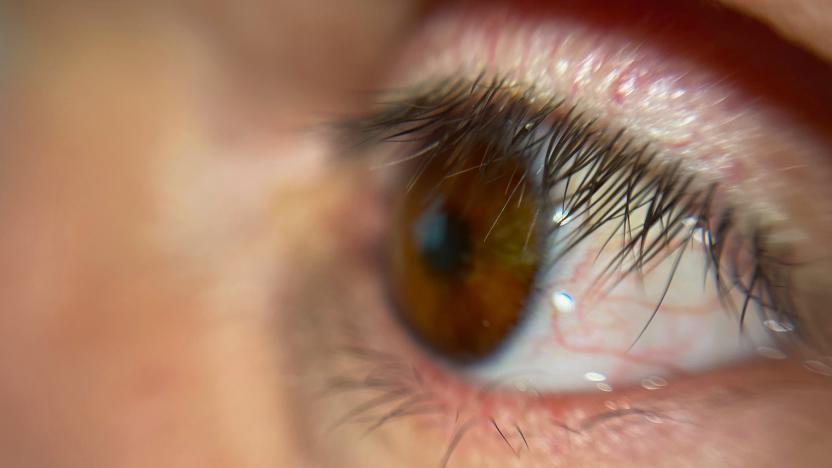Fraunhofer
Latest

Patient receives the world's first fully 3D-printed prosthetic eye
A patient has been fitted with a highly realistic 3D printed prosthetic eye for the first time ever.

New H.266 codec uses half the data to stream 4K video
Fraunhofer, the German company that helped develop the H.264, H.265 and MP3 encoding formats, has unveiled a new video encoding standard that could severely reduce streaming bottlenecks. Called H.266/Versatile Video Coding (VVC), it’s specifically designed for 4K and 8K streaming and reduces data requirements by around 50 percent compared to H.265 HEVC (high-efficiency video coding).

Algae can survive nearly a year and a half in outer space
Algae from the Arctic Circle are used to tough weather, and it turns out they're also able to survive the extreme conditions of outer space. Two specimens recently spent 16 months on the exterior of the International Space Station and became the first plants to make it through these conditions. The algae, of the Sphaerocystis species, returned to Earth last June after 530 days on a panel outside the ISS, the Fraunhofer research organization announced last week. The specimens withstood conditions including intense ultraviolet radiation, temperatures ranging from -20°C to 47.2°C, and, of course, the vacuum of space.

Audio software can make phone calls more intelligible
It can be tough hearing each other on the phone no matter how much you shout if you're in a noisy environment. Fraunhofer believes its new audio software can solve that problem, though, and make even garbled loudspeaker announcements at train stations more understandable. The German research organization's ADAPT DRC software uses microphones to listen to and analyze ambient noise. If it senses that it's rather noisy around you, it boosts certain parts of your speech, particularly consonants like "p," "t" and "k."

Fraunhofer iPad app guides liver surgery through augmented reality
Liver surgery is more than a little dangerous -- with so many blood vessels, one wrong cut can lead to disaster. Fraunhofer MEVIS has just tested a new generation of augmented reality iPad app that could minimize those risks. The tool puts a 3D vessel map on top of live video of a patient, telling the surgeon where it's safe to make incisions. Doctors who do need to cut vessels can predict the level of blood loss and remove affected vessels from the map. The trial was successful enough that Fraunhofer MEVIS sees the new technology applying to surgery elsewhere in the body. If all goes well, there should be fewer accidents during tricky operations of many kinds -- a big relief for those of us going under the knife. [Thanks, Urban]

Researchers achieve world record in wireless data transmission, seek to provide rural broadband
Speed. It's a movie. It's a drug. And it's also something that throngs of internet users the world over cannot get enough of. Thankfully, the wizards at the Fraunhofer Institute for Applied Solid State Physics and the Karlsruhe Institute for Technology have figured out a way to satisfy the unsatisfiable, announcing this week a world record in the area of wireless data transmission. Researchers were able to achieve 40Gbit/sec at 240GHz over a distance of one kilometer, essentially matching the capacity of optical fiber... but, you know, without the actual tether. The goal here, of course, isn't to lower your ping times beyond where they are already; it's to give rural communities across the globe a decent shot at enjoying broadband. Distances of over one kilometer have already been covered by using a long range demonstrator, which the Karlsruhe Institute of Technology set up between two skyscrapers as part of the project "Millilink." There's no clear word on when the findings will be ported over to the commercial realm, but given the traction we're seeing in the white spaces arena, we doubt you'll have to wait long.

Fraunhofer releases its 'CD-like' audio codecs to developers, lends a little HiFi to VoIP apps
For those who relish high fidelity but not high data consumption (and bills), Fraunhofer introduced its IIs Full-HD codec for Android and iOS earlier in the year, which is currently being used in apps like Facetime. Now you can bring some of that "CD-like" audio quality to your own VoIP app development with the release of the Fraunhofer FDK Codec Library for Android 4.1 and up, iOS 4.0 or higher and OSX. That'll let you build less tinny VoIP apps across platforms with "direct, native access" to all the IIs codecs, according to Fraunhofer. Grab it from the coverage below, or check the PR after the break.

Fraunhofer develops extra-small 1Gbps infrared transceiver, recalls our PDA glory days
Our 1997-era selves would die with envy right about now. Fraunhofer has developed a new generation of infrared transceiver that can transfer data at 1Gbps, or well above anything that our vintage PDAs could manage. While the speed is nothing new by itself -- we saw such rates in 2010 Penn State experiments -- it's the size that makes the difference. The laser diode and processing are efficient enough to fit into a small module whose transceiver is as large as a "child's fingernail." In theory, the advancement makes infrared once more viable for mobile device syncing, with room to grow: even the current technology can scale to 3Gbps, lead researcher Frank Deicke says, and it might jump to 10Gbps with enough work. Along with the usual refinements, most of the challenge in getting production hardware rests in persuading the Infrared Data Association to adopt Deicke's work as a standard. If that ever comes to pass, we may just break out our PalmPilot's infrared adapter to try it for old time's sake.

Fraunhofer black silicon could catch more energy from infrared light, go green with sulfur
Generating solar power from the infrared spectrum, or even nearby frequencies, has proven difficult in spite of a quarter of the Sun's energy passing through those wavelengths. The Fraunhofer Institute for Telecommunications may have jumped that hurdle to efficiency through sulfur -- one of the very materials that solar energy often helps eliminate. By irradiating ordinary silicon through femtosecond-level laser pulses within a sulfuric atmosphere, the technique melds sulfur with silicon and makes it easier for infrared light electrons to build into the frenzy needed for conducting electricity. The black-tinted silicon that results from the process is still in the early stages and needs improvements to automation and refinement to become a real product, but there's every intention of making that happen: Fraunhofer plans a spinoff to market finished laser systems for solar cell builders who want their own black silicon. If all goes well, the darker shade of solar panels could lead to a brighter future for clean energy.

Fraunhofer's Full-HD Voice brings high fidelity VoLTE to Android smartphones
The audio nerds at Fraunhofer are set to raise the bar for Voice over LTE next week in Barcelona, as the company has announced a new technology known as Full-HD Voice. By leveraging the AAC-ELD codec, Fraunhofer claims that consumers will experience audio quality that rivals the experience of chatting face-to-face. Technically speaking, it's said the codec offers four times the audio bandwidth of regular phone calls and twice the bandwidth of HD voice services, all without an increase in bit rate. The technology will only be available for Android phones initially, but that seems like a fine place to start. The full PR is after the break -- presented in Full HD, of course.

DASH promises stutter free streaming video over LTE, hopes you don't care about quality
We've all been there: fire up a clip from YouTube or a movie on Netflix and things start out great. But, then, after just a few moments, that LTE connection starts to give up the ghost and suddenly you're faced with unbearable stuttering or a video that just dies mid stream. Researchers at the Fraunhofer Institute for Telecommunications are looking to solve that conundrum with DASH, or Dynamic Adaptive Streaming over HTTP. The idea is actually surprisingly simple -- files of different sizes and qualities will be available depending on signal strength and network load, and the stream will be able to seamlessly switch between them as these variables change. While this sounds like a win for both consumer and carriers, we're sure there are a few of you out there who just want the highest quality possible, even if that means waiting forever for that HD clip of the all accordion cover of Take On Me to buffer. Full PR is after the break.

Fraunhofer's STAN: four cameras, three dimensions, no glasses
There are some glasses-free 3D TVs around, but their limited viewing angles and poor picture quality aren't very inspiring -- so Fraunhofer's latest project is a welcome endeavor. It's developed STAN (STereoscopic ANalyzer), a system that lets broadcasters easily use four cameras instead of the usual two, for 3D recording. 3D needs a minimum of two lenses to register depth and keeping multiple shooters in sync is tough and expensive. That's led to the industry relying on two, which is why glasses-free (autostereoscopic) 3D TVs get such a poor picture; more cameras means more viewing angles. STAN co-ordinates the setup of the four cameras and then uses a feature detector to identify common elements in the pictures and merges them into a 3D image. Four cameras provide much more depth, which means more viewing angles, which means that if STAN gets picked up, these guys can throw away the sunglasses, even for live broadcasts.

Viatag NFC system pays parking lot fees with an RFID tag, saves lives
Paying for parking isn't exactly a fun experience, but Germany's Fraunhofer Institute is doing its best to make it slightly less painful, with Viatag -- an NFC system that allows you shell out your hard earned cash without even reaching for your wallet. The setup is relatively simple, consisting of a small RFID tag, compatible transceivers and a centralized database. Once attached to your car's windshield, the tag communicates with the transceivers installed within a given parking lot, alerting the system whenever your vehicle enters or leaves. An application running on the central server, meanwhile, keeps track of how much time you spend in the lot, and charges your debit card accordingly. Researchers have already installed Viatag at car parks in Essen, Duisburg and Munich, and are hoping to expand it to other locations. It might not be as sophisticated as some of the other automotive communications systems we've seen, but it could come in handy during those moments when you really don't feel like swearing at a parking meter. Cruise past the break for the full PR.

Wimbledon NetMix lets you turn down on-court grunts in favor of staid commentary
Wimbledon, typically a quiet leafy suburb in the great urban sprawl of London, tends to get a little noisier around this time of the year as the world's top tennis players descend upon it with a grunt and a huff of exertion. It's precisely those un-British howls of effort that the BBC is offering to filter out for you with a new Wimbledon NetMix tool. It's a simple audio mixing slider, available to BBC Radio 5 Live listeners, that adjusts the balance between ambient on-court sound and the soothing timbre of commentators' voices. The technology's enabled by the guys and gals at Fraunhofer, who were nice enough to do it for free, and is being introduced in response to a great many complaints received by broadcasters about the primal screaming that's accompanied this year's matches. If the reaction to the NetMix slider is positive, it could find further job opportunities on the Beeb's iPlayer or in coverage of other sporting events.

Ultra-thin handheld microscope could sniff out skin cancer, forged documents
It may not look like it, but that sleek black thing pictured above is actually a microscope. Designed by engineers at Germany's Fraunhofer Institute for Applied Optics and Precision Engineering IOF, this little guy boasts a 5.3mm optical length, rendering it slim enough to fit in the palm of your hand, yet powerful enough to deliver images at a scanner-like resolution of five micrometers, over a wide surface area. Fraunhofer's researchers achieved this balance by essentially tossing out the manual on traditional microscope design. Whereas most devices slowly scan areas and construct images on a piecemeal basis, this handheld uses several small imaging channels and a collection of tiny lenses to record equal sized fragments of a given surface. Unlike conventional scanner microscopes, all of these 300 x 300 square micrometer imaging channels are captured at the same time. With a single swipe, then, users can record 36 x 24 square mm shots of matchbox-sized objects, without even worrying about blurring the images with their shaky hands. The prototype is still two years away from going into production, but once it does, engineers say it could help doctors scan patients for skin cancer more easily, while also allowing bureaucrats to quickly confirm the authenticity of official documents. We can only imagine what it could do for Pac-Man. Full PR after the break.

Eye-tracking microdisplay delivers Terminator vision, distracts joggers
The folks at Fraunhofer IPMS have done it! After years of tireless research and promises of Borg-like eyewear, the group has delivered a prototype of the world's first bidirectional, eye-tracking OLED microdisplay (got all that?) at SID 2011. The rig is much like a monocle, except with a transparent OLED display inside, which overlays digital information on top of the reflected light that usually hits your eyeballs. What's more, there are integrated photodetectors inside and special software to monitor the direction of your gaze, allowing you to interact with your newfound augmented reality using only the flick of an eyeball. Fraunhofer foresees joggers taking in movies while out for a run, which sounds more than just a little dangerous. We, on the other hand, envision a world in which the first thing anyone does upon meeting someone new is discreetly check their relationship status on Facebook -- finally fulfilling the social network's full creep potential. One more pic and the poorly translated PR after the break.

Researchers steal iPhone passwords in six minutes (video)
Losing your smarpthone is bad enough. But if you lose your iPhone and don't issue a remote wipe command (available for free with the Find My iPhone app) then you could find yourself in a world of hurt. Researchers at the Fraunhofer Institute Secure Information Technology (Fraunhofer SIT) can jailbreak and decrypt passwords from the iPhone's keychain -- for say, your Gmail account, corporate VPN, home WiFi, and MS Exchange -- in about six minutes using existing, known exploits. Sorry kids, your flimsy lockscreen passcode won't help. Video proof, after the break.

German researchers prototype 6mm thick pico projector
Pico projectors just keep shrinking, and a new prototype developed at the Fraunhofer Institute for Applied Optics and Engineering is helping said shrinking along pretty strikingly. The team has developed a prototype pico which is just 6mm thick, making it the world's slimmest ever. Better yet, the projected image is 10 times brighter than a pico projector of its size would have previously been -- had it existed. The new lens on the projector is so small that it could potentially be integrated into smart phones without boosting size or weight. The new prototype is made of 45 red, green or blue microlenses, each with a 200 x 200 pixel LCD, inspired by a microlens array called a fly's eye condenser. The resulting resolution is nearly, but not quite, WVGA with 11 lumens of brightness. The prototype will be shown off at Nano Tech 2011 in Tokyo. [Image credit: Fraunhofer Institute]

'Trilobite' compound eye puts a Paleozoic spin on mobile camera design
Extinct marine arthropods make for great design references -- just ask Andreas Brückner. The Fraunhofer Institute of Applied Optics and Precision Engineering researcher has taken a cue from the trilobite in creating a 1.4mm thin "cluster eye" camera to take 221 images at 39 pixels per side to form a 700 x 550 (0.38 megapixel) composite. At this point, it's also capable of recording 13 frames per second for video, and with a size like that, if they can bump up the specs it could pave way for smaller camera components in mobile phones. Not anytime soon, of course, as it's still in the research state (and it's just one of many camera research projects out there). The next step for Brückner and company is shrinking the aforementioned design to 1mm thin (and up the video to 30fps), as well as 1.5mm variant with one megapixel resolution.

Fraunhofer IIS uses Awiloc indoor positioning magic to guide museum patrons
If you've been to a museum in the past year and change, chances are you've been coerced into ponying up an extra five bones for some sort of handheld apparatus. Supposedly, these things accompany patrons and enhance the experience, but more often than not, you're stuck with a grimy audio device that tells you little more than you brother Bob, who is undoubtedly tagging along behind and educating everyone in a 50 foot radius. Folks who choose to spend their time waltzing through the Museum of Industrial Culture in Nuremberg, however, have it better. The Fraunhofer IIS has developed a new technology for WLAN-based positioning, and unlike conventional GPS approaches, Awiloc actually works indoors. As the story goes, visitors to the museum can grab a handheld that follows their movement and then shows them what they're facing (or aren't facing, for that matter) in detail. Of course, they could also use the tracking data to see which exhibits were drawing the most attention if they were smart, but how exactly would the privacy advocate in you feel about that?








